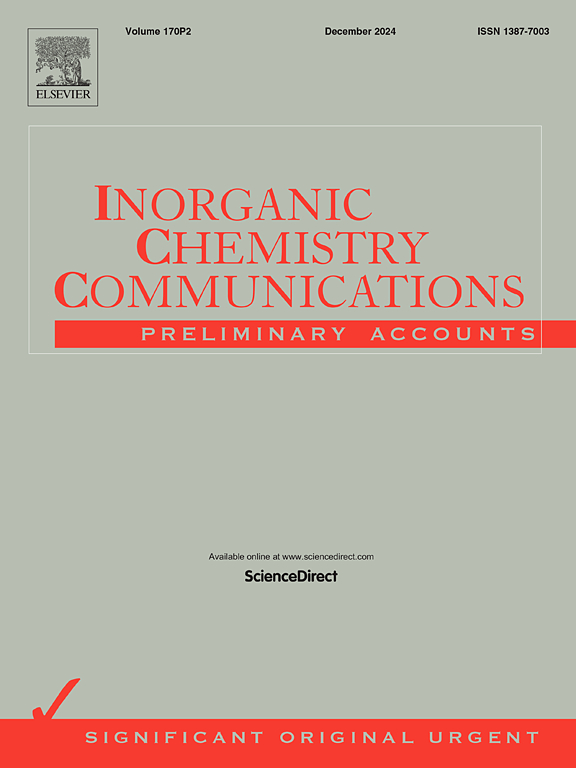Synergistic effect of molar ratio on lead removal by Zn-Al layered double hydroxide
IF 4.4
3区 化学
Q1 CHEMISTRY, INORGANIC & NUCLEAR
引用次数: 0
Abstract
This study investigates the removal of Pb(II) ions from aqueous solutions using Zinc Aluminum Layered Double Hydroxide (Zn/Al LDH) synthesized at different Zn molar ratios (1:1, 1:2, 2:1, 1:3, and 3:1). The adsorption efficiency of Zn/Al LDH was evaluated through batch adsorption experiments, and the effects of varying the molar ratios on adsorption capacity were examined. Characterization techniques including X-ray diffraction (XRD), Brunauer-Emmett-Teller (BET), field emission scanning electron microscopy (FESEM), energy dispersive X-ray analysis (EDX), Fourier-transform infrared (FTIR) as well as thermogravimetric analysis (TGA-DTG) were employed to analyze the structural and morphological properties of the synthesized materials. The Langmuir, Freundlich and Temkin isotherm models were applied to describe the adsorption process, revealing that the adsorption is best described by the Langmuir isotherm, indicating monolayer adsorption. The results demonstrated that the LDH with a 1:2 M ratio exhibited the highest adsorption capacity with 275.28 mg/g, attributed to its greater specific surface area and optimal distribution of active sites. The adsorption of Pb(II) ions onto Zn/Al LDH likely involves multiple mechanisms, such as surface adsorption, ion exchange, and chemical interactions. This study highlights the potential of Zn/Al LDH as an effective adsorbent for the removal of heavy metals from wastewater, with the molar ratio of Zn to Al playing a crucial role in determining the adsorption efficiency.
摩尔比对锌铝层状双氧根除铅的协同效应
本研究研究了在不同锌摩尔比(1:1,1:2,2:1,1:3和3:1)下合成的锌铝层状双氢氧化物(Zn/Al LDH)对水溶液中Pb(II)离子的去除效果。通过批量吸附实验评价了Zn/Al LDH的吸附效率,考察了不同摩尔比对吸附量的影响。采用x射线衍射(XRD)、布鲁诺尔-埃米特-泰勒(BET)、场发射扫描电镜(FESEM)、能量色散x射线分析(EDX)、傅里叶变换红外(FTIR)和热重分析(TGA-DTG)等表征技术对合成材料的结构和形态特性进行了分析。采用Langmuir、Freundlich和Temkin等温线模型描述吸附过程,结果表明Langmuir等温线最能描述吸附过程,表明吸附为单层吸附。结果表明,1:2 M比的LDH吸附量最大,吸附量为275.28 mg/g,比表面积大,活性位点分布最佳。Pb(II)离子在Zn/Al LDH上的吸附可能涉及多种机制,如表面吸附、离子交换和化学相互作用。本研究强调了Zn/Al LDH作为一种有效的吸附剂去除废水中重金属的潜力,其中Zn与Al的摩尔比对吸附效率起着至关重要的作用。
本文章由计算机程序翻译,如有差异,请以英文原文为准。
求助全文
约1分钟内获得全文
求助全文
来源期刊

Inorganic Chemistry Communications
化学-无机化学与核化学
CiteScore
5.50
自引率
7.90%
发文量
1013
审稿时长
53 days
期刊介绍:
Launched in January 1998, Inorganic Chemistry Communications is an international journal dedicated to the rapid publication of short communications in the major areas of inorganic, organometallic and supramolecular chemistry. Topics include synthetic and reaction chemistry, kinetics and mechanisms of reactions, bioinorganic chemistry, photochemistry and the use of metal and organometallic compounds in stoichiometric and catalytic synthesis or organic compounds.
 求助内容:
求助内容: 应助结果提醒方式:
应助结果提醒方式:


